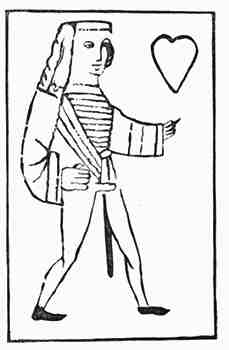|
Tarot History Search started September 2004 |
William Chatto (1799 - 1864) |
||
| Chatto had an interest in wood engravings (publication in 1844) and in the course of this interests he also wrote about playing cards (1848)..... Later addition to article: The book of Chatto "Facts and Speculations on the Origin and History of Playing Cards (1848)" was made available online by books.google.com (some time after this article was written) : http://books.google.com/books?id=y99CAAAAIAAJ&hl=de ... His work about playing cards was considered as the best of his time. He was the first who opened the theory, that the cards might have come from India or China. Chatto knew a Chinese dictionary (first published 1678, the compiling author was Eul-koung), which stated, that cards were invented in China during the reign of Seun-Ho in 1120 to amuse his many concubines (? see Wilkinson article, who contradicts this representation). Also Chatto researched details of Indian culture and "believed, that both chess and cards were probably invented in Hindustan" (compare Kaplan Encyclopedia I, p. 18 + 20, articles CHAR-TAJ and SEUN-HO). The Hindustan context was already researched before Chatto by Samuel Weller Singer (writing 1816, compare Kaplan I. p. 19, article HINDUSTANS AND SARACENS). (From the advertisement of a CD-Rom with Chatto's work) "William Andrew Chatto "Facts and Speculations on the Origin and History of Playing Cards": .... this book is one of the major works on the history and design of playing cards. It has been reprinted for $69 list price but is out of print .... The book presently lists for sale for $200.00. ... The book is an interesting and detailed ramble through the subject. The scholarship is serious and reflects extensive research. The book starts with a section on the possible origins of cards, moves into a long section on the early history of cards in Europe, runs through many details on the cards themselves, and finishes with a discussion of the history of moralizing about cards. The book was published much earlier than Catherine Hargrave's History of Playing Cards, and has more detail in many respects than Hargrave's, and doesn't spend all the time on the modern history of cards that she does. Chatto is mainly interested in the ancient history of cards, and examines it very well in this book. Example from the book: "Some of the specimens of Portuguese cards given in the "Jeux de Cartes Tarots et de Cartes Numerales have very much the appearance of having been originally suggested by, if not copied from, an Oriental type; more especially in the suits of Danari and Bastoni, Money and Clubs. In those cards the circular figure, generally understood as representing Danari, or Money, is certainly much more like the Chakra, or quoit of Vichnou [Vishnu], as seen in Hindostanee drawings, than a piece of coin; while on the top of the Club there is a diamond proper, which is another of the attributes of the same deity." Also worthy of note are the Rosicrucian and Masonic emblems appearing on various mediaeval decks. As the secrets of these organizations were often concealed in cryptic engravings, it is very probable that the enigmatic diagrams upon various decks of cards were used both to conceal and to perpetuate the political and philosophical arcana of these orders. The frontispiece of Mr. Chatto's book shows a knave of hearts bearing a shield emblazoned with a crowned Rosicrucian rose." Chatto's work "Facts and Speculations on the Origin and History of Playing Cards" is now available in an Online Edition. It includes some reproductions of older playing cards, as the following, which shows a card from a deck, assumed to be produced 1497 for the marriage of the son of Emperor Maximilian with a Spanish princess in 1497. The suit of Pomegranates was likely developed to honour the recent successfull occupation of Granada. Publications
Foreign Links
"The History of Playing Cards" in "The Gentleman's Magazine" Short treatise to Chatto's book. (1848) The Gentleman's Magazine |
 Chatto in 1844 Personal Note: I was puzzled, cause I didn't know this card - later I found this in "Altdeutsche Spielkarten, 1500 - 1650" (Hoffmann): "Taylor stellt 1865 die nahe Verwandtschaft der Karten des Stukeley und denen des British Museums fest. Merlin lehnt 1869 Chattos These, die Karten seien mit der Schablone gefertigt, ab und gibt die Stukeley-Karten auf Tafel 63 wieder, ohne sich in der Datierung festzulegen. In dem Katalog ihrer Sammlung, in der sich die Stukeley-Karten inzwischen befanden, gibt Lady Schreiber eine genaue Beschreibung der Provenienz, lehnt Chattos Datierung als zu früh ab, wiederum ohne sich festzulegen. Gegen die latente und manifeste Frühdatierung hat Rosenfeld 1958 Einspruch eingelegt. Er untersuchtdie Fundberichte, um festzustellen, dass die Angaben so ungenau sind, dass eine Datierung praktisch ins gesamte 16. Jahrh. möglich sei. Die Kleidung der Figuren dagegen gehöre durchaus in die erste Hälfte des 15. Jahrhunderts. Für die Karten des Stukeley entscheidet sich Rosenfeld für das Datum 'um 1550'." ... "Das Datum 'um 1440' ist kaum zu halten, doch gibt es ein Indiz, dass es vor 1518 datiert werden kann. Das Fragment Fol 8 zeigt eine Herz-10, die mit einem lateinischen Kreuz (+) statt mit den üblichen Andreaskreuz (x) gekennzeichnet ist. Dieses Lateinische Kreuz verbietet der Nürnberger Rat 1518." | |
| © copyright:
autorbis.net. Links at the site might lead to foreign
sources. We're not responsible for the contents of
these sites.
If you're interested to communicate or to add
informations to some of our articles or to publish articles to the theme of Tarot in 15th century, please send your mail to the webmaster |